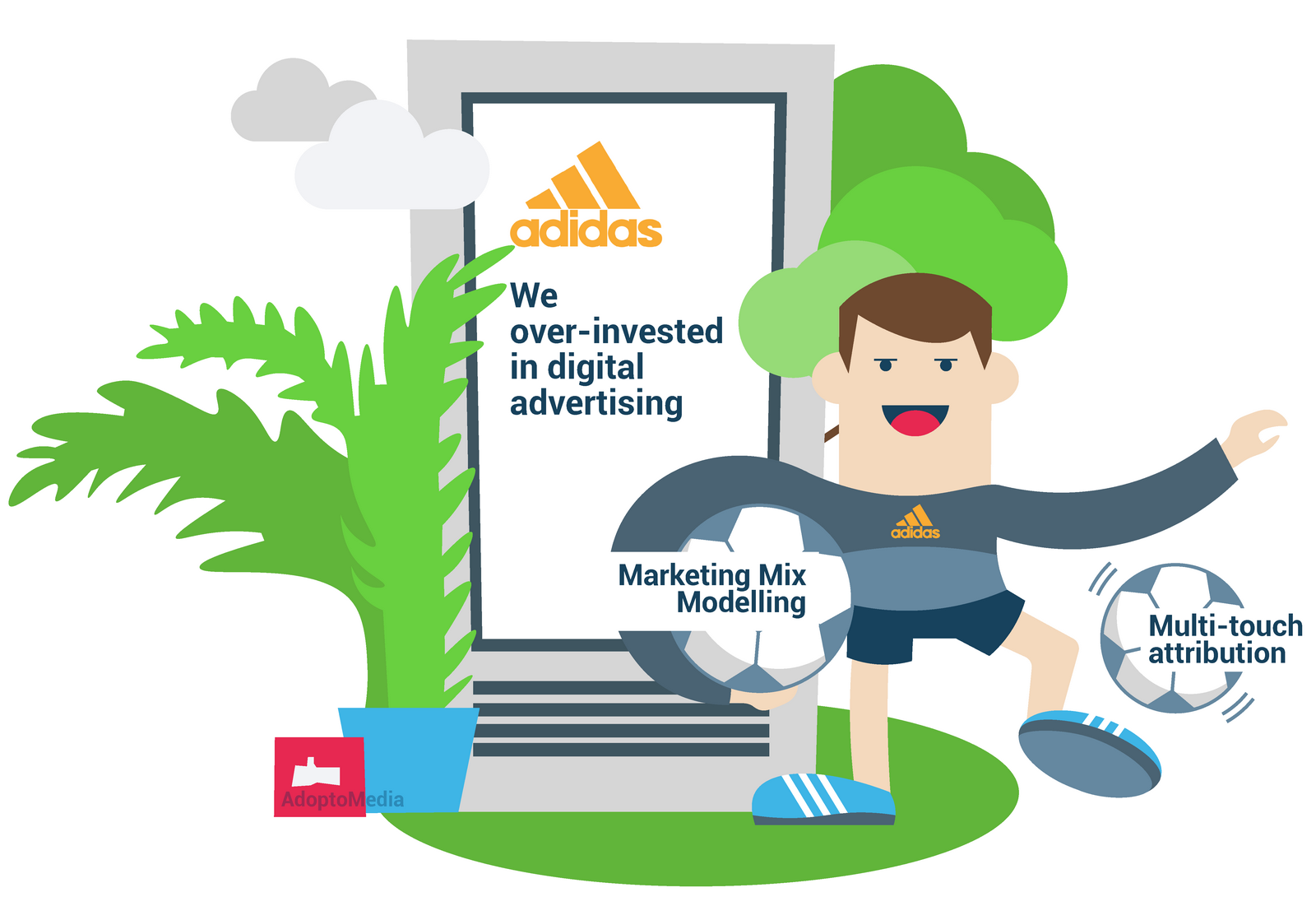
Research shows that using marketing technology to measure effectiveness results in significant performance improvement. But what if the approach you use is flawed and measurement results are only preventing your business from making the most of advertising. Such was the case with Adidas that had been over-investing in digital channels due to MTA analytics.
Turns out even multinational corporations like Adidas aren’t immune to mistakes. But who can blame them? I mean, weren’t we all charmed by promising advantages of multi-touch attribution. It’s a relatively new tool that functions at a highly granular level and is perfectly suitable for evaluating digital campaign performance. MTA can analyze individual customer journey and find what marketing activities lead to conversion. This high level of granularity makes you think that the tool is more accurate than it really is, but this major strength became its main problem when legal restrictions concerning data privacy came into force. GDPR severely limits the potential of attribution. Other limitations of MTA are:
- It covers a limited number of KPIs
- Most models cover only digital channels and can’t account for offline touchpoints.
- It attributes too much credit to digital advertising
- Privacy regulations limit its functionality (especially the recent changes related to the limitation of third-party cookies and IDFA)
- It’s difficult to stitch touchpoints from different devices into a single customer journey
- It’s not transparent enough, so a lot of marketers don’t understand how it functions.
MTA can still be helpful with targeted application in the areas where it is most useful, for example, it allows for optimization of formats and creatives within a channel. MTA does result in temporary ROMI increase, but focusing on efficiency instead of effectiveness is harmful for the brand strength. And researches prove that brand is the most valuable asset of a company, that drives enterprise value and long-term growth. Adidas had also prioritized cost saving initiatives and paid too much attention to ROI sacrificing brand building to some extent. But as researches show, cutting expenses is less effective than optimizing them in the long term. Now the company is shifting its focus back to marketing effectiveness, which is the right strategy.
Considering the drawbacks of MTA, it doesn’t come as a surprise that the company tried to find a new approach. They turned to MMM for accurate analysis of their media mix. MMM is a time tested approach, that accounts for major sale drivers and works with numerous KPIs simultaneously. Here is a more detailed article about advantages and disadvantages of multi-touch attribution and Marketing Mix Modeling. The company’s global media director, Simon Peel, says that in 2015 they were relying on last-click attribution and weren’t applying any econometric models. The wrong strategy even resulted in an excessive supply problem and price sensitivity. Work with numerous agencies and lack of a unified measurement approach caused competition between the company’s divisions and conflicting advertising. But Adidas has been working on the problem and changed the approach. Now they use emotional brand-building activity a few times a year, and at the same time run rational advertising.
They used to invest a lot in performance ads on ecommerce platforms believing that this type of ads drove digital sales. As online sales generate most of the profit, they wanted to boost sales in the sector, but ended up over-investing in it. One of MTA’s drawbacks is that it often assigns too much credit to digital channels because it simply doesn’t cover offline touchpoints. But when they started using econometrics they saw that some of their actions were wrong. Actually marketing mix modeling and multi touch attribution often show different results for the same marketing activities. Namely, econometrics revealed that 60% of revenue was generated by first-time, not loyal customers, which means Adidas needn’t have invested so heavily in CRM. Another surprising thing they learned is that football advertising increased general sales. Also, 65% of online sales were driven not by performance ads but by brand activities, while performance also contributed to offline sales.
The advantage of Marketing Mix Modeling is that it’s pure statistics and data analytics, so it shows facts that help you make right decisions. MMM can show how different channels in your media mix perform, how much incremental sales they drive and where you should invest more. For example, Adidas had allocated 23% of advertising budget to brand and 77% to performance, but it wasn’t the best decision. According to L.Binet and P.Field, the brand’s share should be increased to 60% . The situation is a result of the wrong focus on short-term results. They prioritized the wrong metrics because they used attribution models (Google Last Click, Google Custom, Adobe and Facebook) and preferred short-term, real-time measurements with focus on ROI and ROAS (return on ad spend). They found their mistake by accident when due to some situation they were unable to invest in SEO in Latin America, which unexpectedly didn’t result in traffic or revenue decrease from paid search.
After Adidas started using econometrics, they improved their marketing strategy and tactics. For example, MMM recommended Adidas to allocate more money to video, which is one of the current internet marketing trends. Previously, they didn’t allocate a signficant amount to this channel because last-click models didn’t attribute much value to it, nor to TV, OOH and cinema for driving ecommerce. Adidas will continue using econometric modeling to optimize their marketing spend and apply a test-and-learn approach at the same time. Adidas is not the only company to change their marketing strategy recently, others include Nestle and Procter & Gamble that established in-house agencies to better manage marketing processes. In Nestle’s case the move was partially triggered by issues with access to data. P&G wanted to optimize their spends. In-house agency is most likely the new standard for the industry, but the transition process has to be carried out carefully with thorough planning and evaluation of your resources and capabilities. Here you can read about the best approach to in-housing.
If you want to try econometric modeling too, we have a suitable tool for you. AdoptoMedia offers an advanced Marketing Mix Modeling platform combined with AI for easy marketing spend optimization. It analyzes your media mix and automatically generates recommendations on its optimization at the level of company branches. Our platform can be smoothly integrated into existing IT infrastructure and has a user-friendly interface. The models pass over 20 statistical test, so we can guarantee highly accurate results. Moreover, the modeling algorithms and verification tests are available to the client, so with us there is no black box, everything is transparent. With AdoptoMedia you can calculate the contribution of every marketing activity to your business KPI, track ROMI in real time and forecast it. We helped our clients to increase ROMI by 10-30%.


